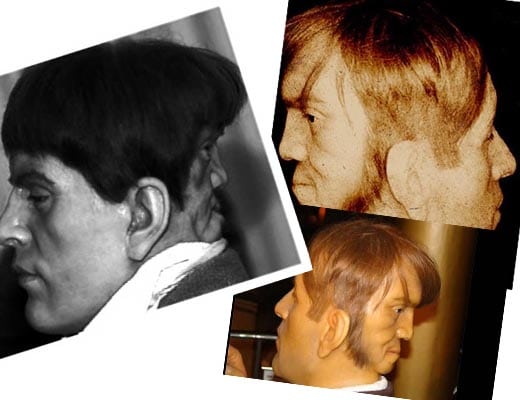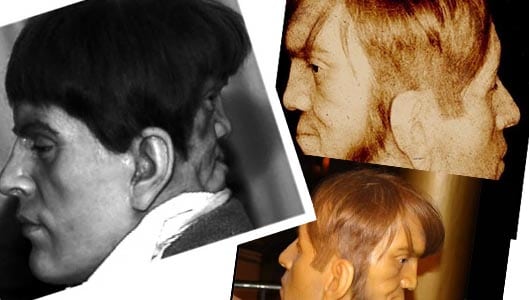The two headed man – Edward Mordrake – fact or fiction?
The tale of Edward Mordrake – the man with two faces – is one that often circulates the Internet, usually attached to a photo apparently depicting the man, along with a spooky short story detailing his background and eventual suicide.
Most versions of the story paint Mordrake as a man haunted by a “demon” second face, a face that despite being ‘dead’, would still whisper to him at night. And while no doctor would consider surgery to remove the second face, Mordrake was eventually driven to madness and subsequently suicide at the age of 23.
Edward Mordrake, the man that was born with a second face on the back of his head, c. 1890
Although it could not speak full words, the second face was able to laugh, cry, and make strange noises without Edward’s control. He reportedly begged doctors to have his “Demon Face” removed, claiming that it whispered to him at night, but no doctor would attempt it. He committed suicide at the age of 23.
Tracking down whether the famous Mr. Mordrake (sometimes called Mordake) really existed and whether this account of his life and ultimate demise is accurate is no easy feat, considering the first accounts of his existence come from questionable sources dating back to the 19th century.
Sponsored Content. Continued below...
Perhaps the first known account of his existence came from a 1895 article by US journalist Charles Lotin Hildreth. Hildreth was a popular author of science fiction and authored many short stories, one of the most popular being the story of a teenager who finds a lost subterranean civilization in the Australian outback. However his most time-withstanding creations come from his newspaper article “The Wonders of Modern Science: Some Half Human Monsters Once Thought to Be of the Devil’s Brood”.
Unlike his sci-fi or horror stories, this was set under the apparent guise of being based on fact, not fiction, though many spectators believe it to nothing more than a hoax, no more real than his short horror stories. In this series, Hildreth introduces Edward Mordrake, a man heir to a noble English peerage, cursed with a second “demon” face. It was this article that is the first verifiable existence of this tale.
Sponsored Content. Continued below...
In fact the tale of Edward Mordrake would have more than likely suffered the same fate as Hildreth’s other works – and that is to say, been buried into obscurity over time – if it wasn’t picked up a year later by the medical encyclopaedia “Anomalies and Curiosities of Medicine” in 1896. That account was copied from Hildreth’s work, which appears to be have been credited as a lay source. The account in the “Anomalies and Curiosities of Medicine” entry goes like this –
One of the weirdest as well as the most melancholy stories of human deformity is that of Edward Mordake, said to have been heir to one of the noblest peerages in England. He never claimed the title, however, and committed suicide in his twenty-third year. He lived in complete seclusion, refusing the visits even of the members of his own family. He was a young man of fine attainments, a profound scholar, and a musician of rare ability. His figure was remarkable for its grace, and his face – that is to say, his natural face – was that of an Antinous. But upon the back of his head was another face, that of a beautiful girl, “lovely as a dream, hideous as a devil.” The female face was a mere mask, “occupying only a small portion of the posterior part of the skull, yet exhibiting every sign of intelligence, of a malignant sort, however.” It would be seen to smile and sneer while Mordake was weeping. The eyes would follow the movements of the spectator, and the lips “would gibber without ceasing.” No voice was audible, but Mordrake avers that he was kept from his rest at night by the hateful whispers of his “devil twin”, as he called it, “which never sleeps, but talks to me forever of such things as they only speak of in Hell. No imagination can conceive the dreadful temptations it sets before me. For some unforgiven wickedness of my forefathers I am knit to this fiend – for a fiend it surely is. I beg and beseech you to crush it out of human semblance, even if I die for it.” Such were the words of the hapless Mordrake to Manvers and Treadwell, his physicians. In spite of careful watching, he managed to procure poison, whereof he died, leaving a letter requesting that the “demon face” might be destroyed before his burial, “lest it continues its dreadful whisperings in my grave.” At his own request, he was interred in a waste place, without stone or legend to mark his grave.
From there the story have been picked up now and again, typically in literary works but also on TV – perhaps most popularly on American Horror Story.
No records of Edward Mordrake exist (and photos spreading online claiming to show the man are mere wax models – the man would have lived before cameras were accessible to the mainstream) and if one was to determine he was a real person, it would have to be assumed that Hildreth’s original account was based on a real person. A cursory glance of similar conditions reveals that such a medical condition is indeed possible – Craniopagus_Parasiticus – a parasitic twinnning pre-birth. However those who have suffered this condition rarely live long after birth and the condition is exceptionally rare.

Photos purporting to show Mordrake actually show wax models.
Hildreth’s only source in the case of 23-year-old Edward Mordrake was to quote the “Royal Scientific Society” where the journalist claimed to have collected old reports of medical curiosities. While this would usually provide an avenue of investigation prior to Hildreth’s 1895 account, we find ourselves unable to continue, since there appears to be no such organisation with that name during that time (a similar Jordanian based research institution founded in 1970 now bears that name.)
As such, to believe the tale of Edward Mordrake is genuine, one would need to assume that a known fiction storyteller penned an article on a truthful subject – an article based on a tale that was neither twisted or embellished over time, as tales have a tendency to do. We are not willing to make any such assumption, and as such, we deem the tale of Edward Mordrake to be more likely fiction than fact.
Continued below...
Thanks for reading, we hope this article helped, but before you leave us for greener pastures, please help us out.
We're hoping to be totally ad-free by 2025 - after all, no one likes online adverts, and all they do is get in the way and slow everything down. But of course we still have fees and costs to pay, so please, please consider becoming a Facebook supporter! It costs only 0.99p (~$1.30) a month (you can stop at any time) and ensures we can still keep posting Cybersecurity themed content to help keep our communities safe and scam-free. You can subscribe here
Remember, we're active on social media - so follow us on Facebook, Bluesky, Instagram and X
